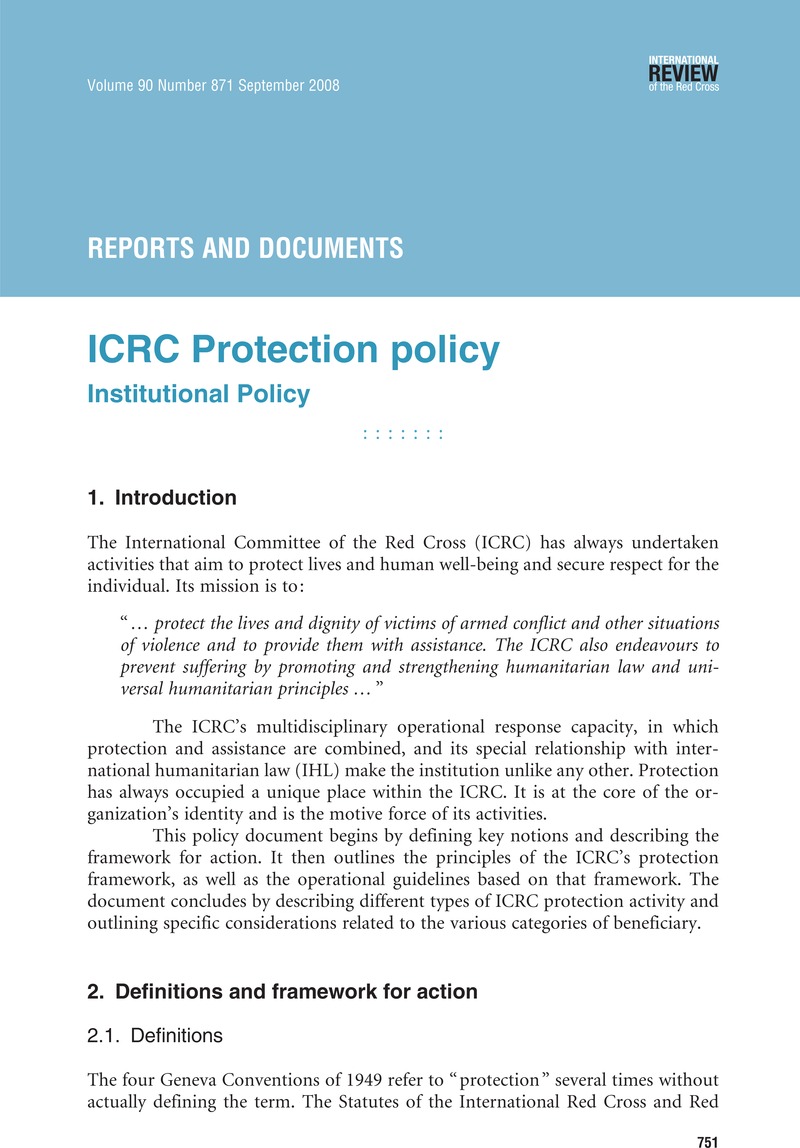Institutional Policy
Published online by Cambridge University Press: 27 March 2009

1 The root of the Latin expression pro tegere, whose literal meaning is “to cover in front” suggests either a curtain or a shelter against the sun or storms, or a screen or shield to protect a person or an object from danger. Synonyms or explanatory terms – safeguard, guaranty, aid, support, envelope, cover, screen, shield, rampart or mask – all connote some sort of security.
2 In this document, the expression “authorities and other actors”covers all authorities and bearers of arms – State entities, armed forces, international peace-keepers, armed groups, clans and other non-State actors – who are able to launch hostile action against persons or a population and who are responsible for protecting those who fall under their control.
3 In this document, the terms “protection,” “protection response,” “protection work,” “protection effort,” “protection approach” or “protection action,” are used as synonyms. They all stand for the entire set of specific protection activities that form the ICRC's protection framework.
4 Four cases can be defined: limited basic needs still being met but which will probably not be met at some time in the future (emerging crises and pre-crisis situations); most basic needs not being met (acute crisis); all or part of basic needs not being met properly, and the existence of a risk of the re-emergence of an acute crisis (chronic crisis); basic needs again being met by existing mechanisms and structures that, however, remain fragile, or basic needs again only being partially met (post-crisis situation).
5 Mainly internationalized internal armed conflicts and peace enforcement operations.
6 This responsibility is of an ethical rather than legal nature. There are a number of competencies that are conferred upon the ICRC, which it is, however, not obliged to exercise; but it has to take into account the short and long-term interests of the victims, humanitarian priorities, and the need to balance different tasks and mandates.
7 The four Geneva Conventions give the ICRC the right to offer its services.
8 In these cases the ICRC may offer its services based on its right of initiative, which is authorized by the Statutes of the Movement.
9 This was elaborated and confirmed by the Strategy of the Movement for restoring family links, which was adopted by the Council of Delegates of the Movement in 2007 (Resolution 4). The Strategy is referred to in Resolution 1 of the 30th International Conference, also held in 2007.
10 Article 1 common to the four Geneva Conventions.
11 The conditions for doing this are defined in the ICRC's institutional policy (see “Action by the International Committee of the Red Cross in the event of violations of international humanitarian law and other fundamental rules protecting persons in situations of violence,” International Review of the Red Cross, Vol. 858, June 2005, pp. 393–400): “(1) the violations are major and repeated or likely to be repeated; (2) delegates have witnessed the violations with their own eyes, or the existence and extent of the violations have been established on the basis of reliable and verifiable sources; (3) bilateral confidential representations and, when attempted, humanitarian mobilization efforts have failed to put an end to the violations; (4) such publicity is in the interest of the persons or populations affected or threatened.”
12 The following developments might constitute a criterion for the ICRC's gradual disengagement from a particular context: a) the end of an armed conflict or other situation of violence; b) a substantial and lasting reduction in the number of people affected, in the gravity of the violations, in the risks and threats, and in the levels of insecurity and tension; c) the establishment or restoration of the rule of law, including the re-establishment of respect for the law; d) the coverage of essential protection needs by the authorities concerned and by official regulatory institutions and mechanisms; e) the durable and efficient intervention of other external actors; f) a marked decrease in the added value of the ICRC's presence; g) the legal, economic and social rehabilitation and integration of the victims; h) the strengthening of civil society, including the capacity of the pertinent National Society to reassume responsibility for certain activities; i) the lack of impact, confirmed over a meaningful period of time, of the entire ICRC protection operation.
13 There are five main pre-conditions governing ICRC visits: 1. Access to all detainees within the ICRC's field of interest; 2. Access to all premises and facilities used by and for detainees; 3. Authorization to repeat the visits; 4. The right to speak freely and in private (without witnesses) with detainees of the ICRC's choice; 5. The assurance that the authorities will give the ICRC a list of the detainees within its field of interest or authorize it to compile such a list during the visit. The ICRC can then at any time check on the detainees' presence and monitor them individually throughout their detention.
14 The Office of the United Nations High Commissioner for Refugees (UNHCR) has the primary responsibility for refugee issues; however, the ICRC also has a responsibility in those instances in which IHL applies, as well as a subsidiary responsibility when UNHCR is absent.